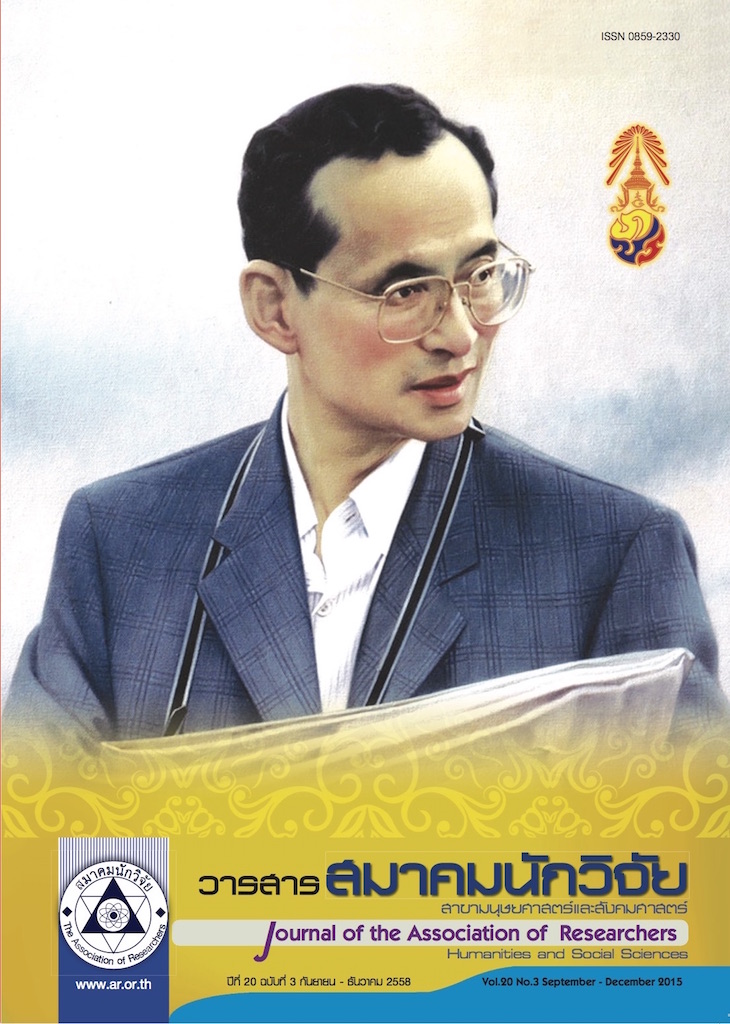Factors Influencing on Intention to Receive Medical Treatment in Thailand : A Case Study in The Republic of the Union of Myanmar
Main Article Content
Abstract
This research's objectives were to analyze the direct and indirect relationship and the effect size between the confidence and behavioral intention of patients toward receiving medical treatment in Thailand. The research was survey research. The population was Myanmar living in Yangon, Republic of the Union of Myanmar, and the unit sampling was 200 people. Analyzing data by using confirmatory factor analysis, and structural equation modeling. The findings were (1) The component factors influencing the confidence and behavioral intention toward receiving medical care were medical services consisted of medical specialist and proficiency of physician, medical technology consisted of high technology of medical appliances, medical treatment plan, and reputation of the hospital. the brand image consisted of the reputation of the hospital, service quality, and reputation of a physician. (2) The most influencing factors of Myanmar toward the confidence and behavioral intention to receiving medical care in Thailand were the reputation of the hospital, medical technology, and reputation of physician respectively
Article Details
บทความที่ปรากฏในวารสารนี้ เป็นความรับผิดชอบของผู้เขียน ซึ่งสมาคมนักวิจัยไม่จำเป็นต้องเห็นด้วยเสมอไป การนำเสนอผลงานวิจัยและบทความในวารสารนี้ไปเผยแพร่สามารถกระทำได้ โดยระบุแหล่งอ้างอิงจาก "วารสารสมาคมนักวิจัย"
References
สำนักส่งเสริมธุรกิจบริการ. (2555). รายงานธุรกิจบริการรักษาพยาบาล. ค้นเมื่อ 15 กุมภาพันธ์ 2556, จาก http://www.ditp.go.th/depthai/attachments/article/doc/55/ 55002841.doc
อัญชนา ณ ระนอง “ภาวะวิกฤตเศรษฐกิจการเป็นศูนย์กลางบริการด้านสุขภาพของประเทศไทย” วารสารพัฒนบริหารศาสตร์ ปีที่ 51 ฉบับที่ 1/2554 หน้า 47-81
Afzal, H., Khan, M. A., ur Rehman, K. Ali, L. & Wajahat, S. (2010). Consumer's trust in the brand: Can it be built through brand reputation, brand competence, and brand predictability. International
Business Research, 3(1), 43-51. Bureau of Policy and Strategy Ministry of Public Health. (2009). Bangkok: The War Veterans Organization of Thailand Under Royal Patronage of His Majesty The King.
Ehrbeck, T., Guevara, C., and Mango, P. D. (2008). Mapping the Market for Medical Travel. Retrieved February 4, 2013. From http://www.mckinseyquarterly.com/Mapping the market for travel 2134
Gan, Lydia L, and Frederick, James R. 2011. Consumers' Attitudes toward Medical Tourism. The University of North Carolina. (May 9, 2011). Available at SSRN: http://ssrn.com/abstract=1837062
Guffey, T & Yang, P, Q, (2012). Trust in Doctors Are African Americans Less Likely to Trust Their Doctors Than White Americans?. Retrieved August 30, 2013. From http://sgo.sagepub.com/content/ 2/4/2158244012466092. full
Jagyasi, P. (2011). Dr. Prem's Guidbook Medical Tourism. CreateSpace: Seattle.
Louis, D., and Cindy, L. (2010). Impact of brand personality on three major relational consequences (trust, attachment, and commitment to the brand).
The Journal of Product and Brand Management 19.2 (2010): 114-130. Peters, C. P., and Sauer, K M. (2011). A Survey of Medical Tourism Service Providers. Journal of Marketing Development and Competitiveness. 5(3), 117-126.
ReportLink (2009). Asia Medical Tourism Analysis. Retrieved August 1, 2011, from http://www.report linker.com/p0149565/Asia-Medical-Tourism Analysis .html
Rosenthal, M. (2004). Older patients' trust and disrupted trust doctors and health plans: Determinants and implications. Retrieved August 30, 2013. From http://search.proquest.com/docview/305120872?accountid=32092. Rose, M. (2010). Thailand Top Medical Tourism Destination. Retrieved August 1, 2011. from http://med blogcontest.com/blog/4/?p=50
Stolley, K., and Watson, S. (2012). Medical Tourism. California: ABC-Clio. Woodman, Josef. (2008). Patients Beyond Borders (2 ed.). New York: Healthy Travel Media.
World Health Organization. (1997). Measuring Overall Health System Performance for 191 Countries. Retrieved February 16, 2013, from www.who.int/healthinfo/paper30.pdf


